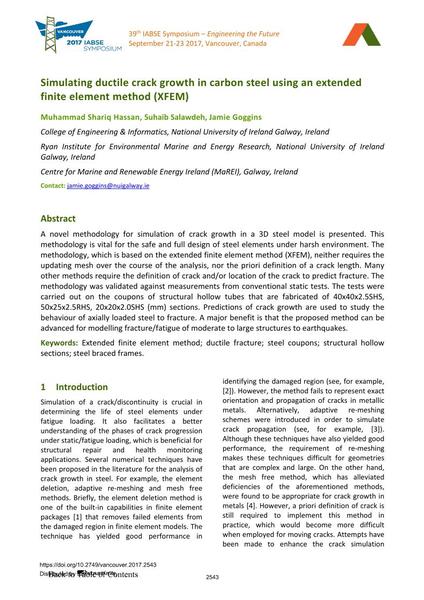Simulating ductile crack growth in carbon steel using an extended finite element method (XFEM)

|
|
|||||||||||
Bibliografische Angaben
| Autor(en): |
Muhammad Shariq Hassan
(College of Engineering & Informatics, National University of Ireland Galway, Ireland)
Suhaib Salawdeh (College of Engineering & Informatics, National University of Ireland Galway, Ireland) Jamie Goggins (College of Engineering & Informatics, National University of Ireland Galway, Ireland) |
||||
|---|---|---|---|---|---|
| Medium: | Tagungsbeitrag | ||||
| Sprache(n): | Englisch | ||||
| Tagung: | IABSE Symposium: Engineering the Future, Vancouver, Canada, 21-23 September 2017 | ||||
| Veröffentlicht in: | IABSE Symposium Vancouver 2017 | ||||
|
|||||
| Seite(n): | 2543-2550 | ||||
| Anzahl der Seiten (im PDF): | 8 | ||||
| Jahr: | 2017 | ||||
| DOI: | 10.2749/vancouver.2017.2543 | ||||
| Abstrakt: |
A novel methodology for simulation of crack growth in a 3D steel model is presented. This methodology is vital for the safe and full design of steel elements under harsh environment. The methodology, which is based on the extended finite element method (XFEM), neither requires the updating mesh over the course of the analysis, nor the priori definition of a crack length. Many other methods require the definition of crack and/or location of the crack to predict fracture. The methodology was validated against measurements from conventional static tests. The tests were carried out on the coupons of structural hollow tubes that are fabricated of 40x40x2.5SHS, 50x25x2.5RHS, 20x20x2.0SHS (mm) sections. Predictions of crack growth are used to study the behaviour of axially loaded steel to fracture. A major benefit is that the proposed method can be advanced for modelling fracture/fatigue of moderate to large structures to earthquakes. |
||||
